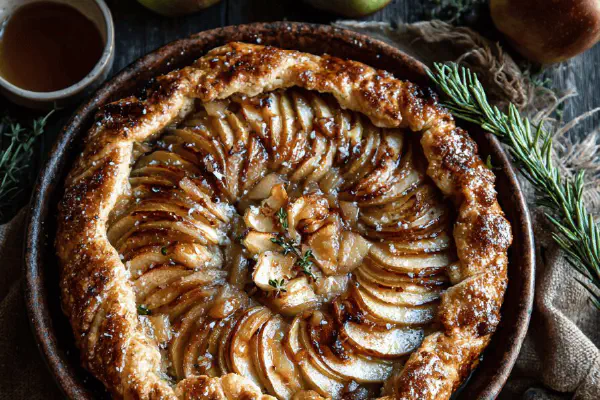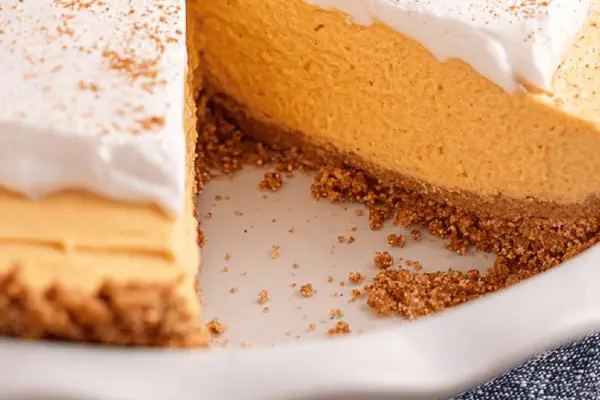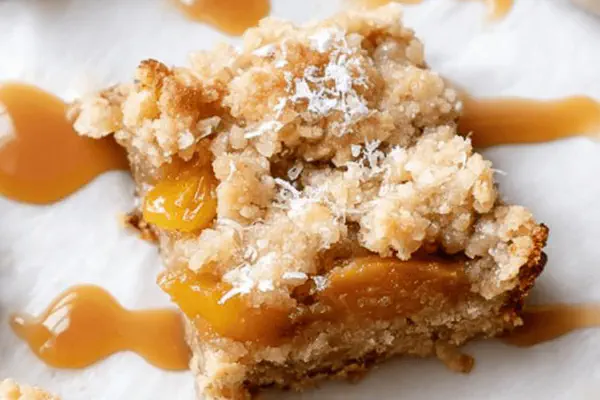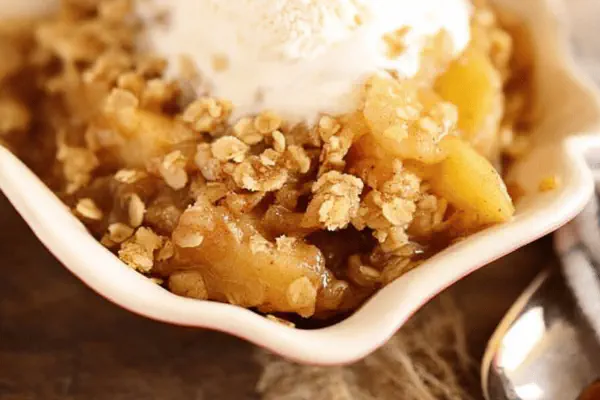Rustic Apple Tart

By Emma
Certified Culinary Professional
Ingredients
- 125 ml (1/2 cup) light brown sugar
- 35 ml (2 1/2 tbsp) cornstarch
- 2.5 ml (1/2 tsp) ground cardamom
- 1 ml (1/4 tsp) ground ginger
- 6 apples mixed varieties (McIntosh, Cortland, Empire or others), peeled, cored, cut into 16 segments
- 30 ml (2 tbsp) light olive oil, warmed
- 2 pie crust sheets 28 cm (11 in) diameter
Egg wash
- 1 egg yolk
- 15 ml (1 tbsp) milk or cream
- 10 ml (2 tsp) pear vinegar
About the ingredients
Method
Preparation
- 1. Position rack low in oven, preheat to 185 °C (365 °F). Slightly lower temp slows crust browning, lets filling bubble through before burn.
- 2. Whisk egg yolk and milk with vinegar, set aside. Vinegar cuts sweetness, aids browning.
- 3. Toss brown sugar, cornstarch, cardamom, and ginger in big mixing bowl. Check spices for freshness; stale make tart flat.
- 4. Add apples and warm olive oil, fold gently. Olive oil avoids butter’s heaviness, adds subtle fruitiness. Avoid squeezing apples too much—they should hold shape while releasing juices. Mixture should glisten, look sticky.
- 5. Roll out first pie dough thin into 23 cm (9 in) pie pan, pressing carefully to avoid air pockets. Prick bottom lightly with fork. Pour filling, press lightly until mostly even but apples peek through gaps.
- 6. Moisten dough edges with cold water — just enough to make edges tacky, don’t overdo or crust gets soggy.
- 7. Lay second dough sheet over, trim excess with sharp knife, pinch edges hard with fingers or fork to seal tight.
- 8. Cut a two-inch slit in center to vent steam evenly; no vent or crust bursts messily—learned hard way. Brush entire top head to toe with egg wash, thick and even. Avoid missing edges, they brown dull otherwise.
- 9. Optional: Use leftover dough to shape mini apples or leaves, stick on top with egg wash. Adds charm but extra sugar might burn faster — watch closely.
Baking
- 10. Oven preheated? Slide tart onto bottom rack. Bubbly juices sound wriggle and pop as tart cooks—listen for quiet simmer, no roaring boil.
- 11. Bake approx 50 minutes; if crust edges brown too fast, tent with foil halfway through to avoid bitter burnt bitterness.
- 12. Checks: crust golden amber, not too dark. Filling bubbling through vents and edges, thickened juice has glossy coat on apples. Slightly soft when poked.
- 13. Cool on wire rack minimum 20 minutes. Filling thickens more upon cooling; cutting too hot means runny juices all over. Chill briefly if impatient.
- 14. Slice with serrated knife, gentle sawing avoids dragging juices out.
- 15. Serve lukewarm or chilled, plain or with dollop crème fraîche or sharp cheddar for counterbalance.
Troubleshooting
- - If crust shrinks, chill dough well before rolling. Too warm, it warps.
- - Soggy bottom? Bake a blind crust 8 mins before adding filling next time. Brush base with beaten egg white for moisture barrier.
- - Filling too runny? Next time increase cornstarch to 40 ml (3 tbsp), or cook apples briefly in skillet to soften excess moisture.
- - Spices overpower? Add grated lemon zest for brightness or swap cardamom for star anise for floral notes.
- - No pie dough handy? Use puff pastry but expect more rise, less rustic look.
Cooking tips
Chef's notes
- 💡 Chill dough like your life depends on it or edges shrink. Work fast, cold hands help. Warm dough means tough crust. Patchy butter melts ruin flakiness. Rest after rolling for cracks to disappear. Keeping dough cold seals steam, avoids soggy bottom. Use light olive oil warmed gently—avoids butter heaviness but doesn't dominate. Don’t squeeze apples; wedges must hold shape. Fold gently, shiny mix means right moisture. Let scent of cardamom and ginger build slowly.
- 💡 Layer crust thin in pan. Prick bottom before filling or bubbles build and burst crust. Fill mostly even but apples peek through gaps to escape steam. Wet edges lightly, just enough to stick. Too much water and edges won’t seal fully, soggy crust risk. Pinch edges hard, no loose seams. Slit two inches in center to vent steam evenly—no slit = messy bust. Egg wash thick and even covers top completely; missed edges stay dull and don’t brown. Add leftover dough shapes but watch sugar near edges burns fast. Always tent foil halfway if edges brown too quick, bitterness ruins slice.
- 💡 Smell guides baking. Bubbly quiet simmer beats roaring boil which signals overheat. Listen for soft rattle of juices, not hard pop. Look for golden amber crust, edges not burnt but darker hue. Juices should thicken visibly through slits and edges, glossy shine on apple wedges, slightly soft when prodded. Cool minimum 20 minutes on wire rack to thicken filling; cut too hot and juices run everywhere. If impatient, chill briefly but avoid fridge long else crust soggy. Slice with serrated knife, gentle saw strokes preserve wedge shape and stop juice loss.
- 💡 If filling too runny next bake boost cornstarch to 40 ml or pre-cook apples briefly in skillet to shed excess moisture. If crust shrinks during baking, chill dough well before rolling. Warmer dough stretches then snaps back. For soggy bottom blind bake pie crust 8 minutes before adding filling, brush base with beaten egg white to create moisture barrier. Swap pear vinegar with apple cider but use less due to stronger taste. Cardamom replaces cinnamon for warm floral spice, ginger takes nutmeg's place for fresh heat. Start half amounts if cardamom new to spice cupboard.
- 💡 Balance spice intensity carefully. Too much cardamom overwhelms; grated lemon zest brightens spice medley if needed. Add star anise or cloves instead for seasonal shifts. Toss dried cranberries or raisins between apple layers for chew and deeper flavor complexity but monitor moisture addition. Splash Calvados or brandy before baking adds boozy depth—use sparingly. Dough handling must be swift to avoid melting butter patches. Rest dough after rolling stops cracks during bake. Bottom rack placement steadies heat for thick bubbling filling. Middle rack risks underbaked bottom or raw center.
Common questions
What causes soggy pie crust?
Too much water on edges or filling moisture leaks down. Chill dough better. Blind bake crust first. Brush base with egg white for barrier. Avoid squeezing apples or they release extra juice. Also use cornstarch properly.
How to tell when tart is done?
Golden amber crust edges but not burnt. Juices bubbling through vent, quiet simmer sound, not loud boil. Apples slightly soft when poked. Filling shiny and thickened visible through cuts. Cool before slicing for thickened filling, else runny mess.
Substitutes for olive oil and spices?
Melted butter if light olive oil unavailable but heavier feel. Coconut oil for subtle tropical note but watch melt point. Replace cardamom with allspice or cloves. Ginger swaps with nutmeg but fresh grated ginger stronger, reduce amount. Vinegar? Apple cider vinegar often too sharp, use less if swapped.
How to store leftovers?
Wrap wrapped tightly, fridge keeps tart fresh 2 days. Warm gently in microwave way too long makes soggy. Leftovers okay lukewarm or chilled. Freeze not ideal, crust texture loss possible. Reheat on low heat oven slows moisture buildup.



